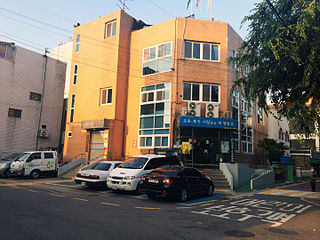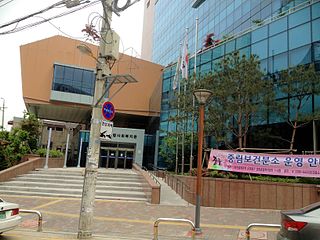Related Research Articles

South Korea is made up of 22 first-tier administrative divisions: 6 metropolitan cities, 1 special city, 1 special self-governing city, and 14 provinces, including three special self-governing provinces and five claimed by the ROK government. These are further subdivided into a variety of smaller entities, including cities, counties, districts, towns, townships, neighborhoods and villages.

Deogyang District (Korean: 덕양구) is a gu (ward) in Goyang, South Korea.

Yangpyeong-dong is a dong, neighborhood of Yeongdeungpo-gu in Seoul, South Korea.

Sogong-dong is a dong of Jung-gu district in Seoul, South Korea.

Gwanghui-dong is a dong (neighborhood) of Jung District, Seoul, South Korea.

Hoehyeon-dong is a dong (neighborhood) of Jung District, Seoul, South Korea.

Jungnim-dong is a dong, neighbourhood of Jung-gu in Seoul, South Korea.

Inhyeon-dong is a legal dong, or neighbourhood of the Jung-gu district in Seoul, South Korea and governed by its administrative dongs, Gwanghui-dong and Euljiro 3, 4, 5ga-dong.
Ipjeong-dong is a legal dong, or neighbourhood of the Jung-gu district in Seoul, South Korea and governed by its administrative dong, Euljiro 3, 4, 5ga-dong.
Mugyo-dong is a legal dong, or neighbourhood of the Jung-gu district in Seoul, South Korea and governed by its administrative dong, Myeong-dong.
Janggyo-dong is a legal dong, or neighbourhood of the Jung-gu district in Seoul, South Korea and governed by its administrative dong, Myeong-dong.
Jeo-dong is a legal dong, or neighbourhood of the Jung-gu district in Seoul, South Korea and governed by its administrative dong, Myeong-dong and Euljiro 3, 4, 5ga-dong.
Juja-dong is a legal dong, or neighbourhood of the Jung-gu district in Seoul, South Korea and governed by its administrative dong, Pil-dong.
Ojang-dong is a legal dong, or neighbourhood of the Jung-gu district in Seoul, South Korea and governed by its administrative dong, Gwanghui-dong.
Namsan-dong is a legal dong, or neighbourhood of the Jung-gu district in Seoul, South Korea and governed by its administrative dong, Myeong-dong.
Namchang-dong is a legal dong, or neighbourhood of the Jung-gu district in Seoul, South Korea and governed by its administrative dong, Hoehyeon-dong.
Ssangnim-dong is a legal dong, or neighbourhood of the Jung-gu district in Seoul, South Korea, and governed by its administrative dong, Gwanghui-dong.
Yonggang-dong is a dong, neighbourhood of the Mapo-gu district in Seoul, South Korea.
Pyeongtaek–Paju Expressway is an expressway in South Korea. It connects Pyeongtaek to Paju in Gyeonggi Province. The expressway's route number is 17, which it shares with the Iksan–Pyeongtaek Expressway. This expressway overlaps with the Capital Region Second Ring Expressway at Hwaseong.
Grand Prince Wolsan was a Korean Royal Prince as the oldest son of Deokjong of Joseon and Queen Sohye. His personal name was Yi Jeong.
References
- ↑ "주교동 (Jugyo-dong 舟橋洞)" (in Korean). Retrieved 2008-05-09.[ permanent dead link ]
Wondang District 1, Jugyo-dong Redevelopment Progress Sep 2007: Designation of maintenance area December 2010: Approval by the Promotion Committee August 2011: Approval of establishment of association September 2015: Approval for business implementation August 2021: Approval for administrative disposition Second half of 2022: Relocation to be completed Second half of 2026: expected to move in
